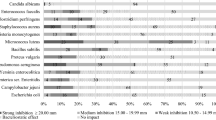Abstract
Locally prepared tempe that underwent natural fermentation was characterized by the growth of Lactobacillus plantarum, Streptococcus lactis , Bacillus sp., Salmonella sp., Klebsiella sp., Lactococcus lactis , Rhizopus sp. and Staphylococcus sp., while fermentation carried out with the addition of varying levels of baobab pulp powder had mainly lactic acid bacteria (LAB)— Lactobacillus plantarum, Lactobacillus fermentum , Lactobacillus acidophilus and Rhizopus sp. dominating. Increasing concentrations of baobab pulp powder led to an increase in the population of lactic acid bacteria (LAB) from 2.3×102 to 3.3×104 while it reduced the population of inoculated Rhizopus from 102 to only six colonies on malt extract agar (MEA).
Similar content being viewed by others
References
Egunlety M (2002) Int J Food Sci Nutr 53:15
Okon PN (1973) Characterization and biochemical studies of Adansonia digitata pulp used for ‘nono’ fermentation. MSc Thesis (Biochemistry) Ahmadu Bello University, Zaria, Nigeria
Steinkraus KH, Hand DB, Van Bureu JP, Hackler LR (1960) Pilot plant studies on tempe. In: Proceedings of Conference on Soybeans Products for Protein in Human Foods, USDA, pp 75–84
Liem ITH, Steinkraus KH, Crouk TC (1977) Production of vitamin B-12 in tempe, a fermented soybean food. App 1. Environ Microbiol 34:773–776
Wang HL, Hesseltine CW (1981) Use of microbial cultures: legume and cereal products. Food Technol 35:79–83
Beuchat LR (1983) Indigenous fermented foods In: Reed G (ed) Biotechnology, vol.5: food and feed production with microorganisms. Verlag Chemie, Weinheim, pp 477–528
Beuchat LR (1984) Fermented soybean foods. Food Technol 38:64–70
Steinkraus KH (1983) Trend and current knowledge in tempe research. Proceedings from the symposium on the utilization of tempe for the improvement of health and nutrition, Jakarta, Indonesia. pp 138–148
Hachmeister KA, Fung DYC (1993) Tempe: a mold modified indigenous fermented food made from soybean and/or cereal grain. Crit Rev Microbiol 19(3):137–188
Sudarmadji S, Markakis P (1978) Lipid and other changes occurring during the fermentation and frying of tempe. Food Chem 3:165–170
Nout MJR, Bonants-Van Laarhoven TMG, de Draux R, Gerats IAGM (1985) The influence of source process variables and storage conditions on the quality and shelf life of soybean tempe. Antonie van Leeuwenhoek 51:532–534
Samson RA, Van Kooji JA, Beboer E (1987) Microbiological quality of commercial tempe in the Netherlands. J Food Protect 50:92–94
Nout MJR, De Dren MA, Zuurbier AM, Bonants van Laarhoven TMG (1987) Ecology of controlled soybean acidification for tempe manufacture. Food Microbiol 4:165–172
Tanaka N, Kovats SK, Guggisberg JA, Meske LM, Doyle MP (1985) Evaluation of the microbiological safety of tempe made from unacidified soybeans. J Food Protect 48:438–441
Nout MJR, Beernink G, Bonants-van Laarhoven TMG (1987a) Growth of Bacillus cereus in soybean tempe. Int J Food Microbiol 4:293–301
Robert KM, Graham HF, Ken AB (1989) The microbial ecology of soybean soaking for tempe production. Int J Food Microbiol 8:35–46
Kandler O, Weiss N (1986) Regular, non-sporing gram-positive rods. In: Holt J (ed) Bergey’s manual of systematic bacteriology, vol. 2. William and Wilkins, Baltimore
Thomas JM, Ciurana B, Jofre JT (1986) New, simple medium for selective, differential recovery of Klebsiella sp. Appl Environ Microbiol 51:1361–1363
Cowan ST, Steel JK (1970) The identification of medical bacteria. Cambridge University Press, London
Krieg NR, Holt JG (1984) Bergey’s manual of systematic bacteriology, vol. 1. Williams and Wilkins, Baltimore
Sneath PHA, Mair NS, Sharpe ME, Holt JG (1986) Bergey’s manual of systematic bacteriology, vol 2. Williams and Wilkins, Baltimore
Sanni AI, Ahrne S, Onilude AA (1995) Production of (- galactosidase by Lactobacillus plantarum isolated from diverse sources. J Basic Microbiol 35:427–432
Sanni AI, Onilude AA, Ogundoye OR (1997) Effect of bacteria galactosidases treatment on the nutritional status of soybean seeds and its milk derivative. Nahrung Foods 41:18–21
Sanni AI, Onilude AA, Ogunbanwo ST, Fadahunsi IF, Afolabi RO (2002) Eur Food Res Technol 215:176–180
Author information
Authors and Affiliations
Corresponding author
Rights and permissions
About this article
Cite this article
Afolabi, O.R., Popoola, T.O.S. The effects of baobab pulp powder on the micro flora involved in tempe fermentation. Eur Food Res Technol 220, 187–190 (2005). https://doi.org/10.1007/s00217-004-0998-y
Received:
Revised:
Published:
Issue Date:
DOI: https://doi.org/10.1007/s00217-004-0998-y




